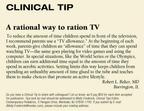Journal Club
JOURNAL CLUB
COMMENTARIES BY MICHAEL G. BURKE, MD
Scoliosis screeningis it worthwhile?
School scoliosis screening identifies some children who receive treatment but refers many more who do not, according to a retrospective review of a screening program for children in grades 5 through 9. During the five years of screening, positive results varied from year to year. Of 2,242 children who had at least three annual screenings, 92 (4.1%) were referred for further evaluation. Of these, 68 (74%) had documented scoliosis follow-up. Since only five of the 68 actually required treatment, the screening resulted in referrals for 87 children who were not treated. Eleven students diagnosed with scoliosis never failed a school screening. Given the low prevalence of treated scoliosis, the positive predictive value for the program was only 5%, with 448 children requiring screening to identify one child who needed treatment (Yawn BP et al: JAMA 1999;282:1427).
Commentary: I thought that the only problem with scoliosis screening was false positives, so I was surprised at how many students with scoliosis never failed the school screen. How much do scoliosis screening programs cost? Is that amount worth identifying one child for every 448 who are screened?
Diagnosing dermatoses with digital images
Dermatologists who examine digital images of skin lesions diagnose dermatoses as reliably and accurately as colleagues who conduct traditional in-person examinations, a new investigation shows. The study was performed with 129 mostly male adults with a total of 168 lesions who consulted a Veterans Affairs dermatology service. Investigators compared the reliability and accuracy of diagnoses by two clinic dermatologists who examined each patient independently and three digital image dermatologist consultants. Digital image examiners were given the patients' standardized history form and the digital images recorded on a compact disc. The clinic-based dermatologists were aware of any presumptive referring diagnosis but gathered other historical and physical examination information at their own discretion.
Each group of dermatologists showed high reliability, with the physicians agreeing among themselves on diagnoses. The digital image examiners and clinic dermatologists were equally good at making accurate diagnoses, which were confirmed with definitive diagnostic tests, when available (Whited JD et al: J Am Acad Dermatol 1999; 41:693).
Commentary: How many times have you wished that a pediatric dermatologist was looking over your shoulder when you approached a child with an unusual rash or skin lesion? Now you may have a digital camera at your side instead.

Probiotics reduce diarrhea
Probiotics administered during antimicrobial treatment of respiratory infections appear to reduce the incidence of antibiotic-associated diarrhea by two thirds. Investigators in Finland studied the effects of an oral probiotic, Lactobacillus GG, in 119 children with a mean age of 4.5 years who were treated with oral antibiotics for acute respiratory infections for seven to 10 days. During this treatment period, half the children received the probiotic and half placebo. Parents kept a daily symptom diary and recorded stool frequency and consistency for three months.
During the two weeks after antibiotics were initiated, three patients (5%) in the Lactobacillus GG group developed diarrhea, compared with nine patients (16%) in the placebo group. Severity of diarrhea was similar in both groups, and 75% of the children with diarrhea were between 3 months and 5 years old. Activity of the gut microflora fecal urease and b-glucuronidase decreased considerably after antimicrobial treatment was begun in both placebo and Lactobacillus treatment groups. The decreases were reversible in patients who did not have diarrhea, but modifications were more profound and prolonged in patients with diarrhea (Arvola T et al: Pediatrics 1999;104[5]e64).
Commentary: Using the same probiotic organism, other investigators have confirmed these findings. In a study of 202 children 6 months to 10 years of age, they report an 8% incidence of antibiotic-associated diarrhea in the group given Lactobacillus GG compared with 26% incidence in the placebo group (Vanderhoof JA et al: J Pediatr 1999;135:564).
I checked today: This probiotic is available both on the Web and over the counter at my local pharmacy. I wonder if we soon will be prescribing probiotics and antibiotics in combination.

Lactose-free formula boosts feeding tolerance
A recent investigation shows that a premature infant formula in which lactose is markedly reduced decreases feeding intolerance in premature infants. Investigators divided 306 infants into groups. Half the groups received lactose-containing formula, breast milk, or lactose-containing formula combined with breast milk. The other half were fed low-lactose formula, breast milk, or low-lactose formula combined with breast milk.
Infants who were fed low-lactose formula had better enteral caloric intake and weight gain, reached full feedings sooner, had fewer gastric residuals, required fewer halts during feeding, and spent less time npo than infants who were fed lactose-containing formula. Investigators had hypothesized that a low-lactose premature infant formula would also decrease the incidence of necrotizing enterocolitis, but it occurred too infrequently to draw conclusions (Griffin MP et al: J Pediatr 1999;135:587).
Commentary: There may be some problems with this study: A large number of patients were fed some or all breast milk, and we are left to assume that exposure to breast milk was equal in the lactose and low-lactose groups. The finding held up when babies exposed to breast milk were excluded, but it is not clear if the reduced numbers leave the study adequate power to detect differences in the outcomes. Other studies will be needed to confirm these findings. I would be interested in seeing one comparing lactose-reduced formula with lactose-laden breast milk. Could it be that in this one case breast isn't best? That would be a real surprise.
Preventing obesity by limiting TV time
Investigators studied about 200 third and fourth graders in two elementary schools to assess the effects of reducing television, videotape, and video game use on obesity, physical activity, and eating habits. Children in one school attended an 18-session classroom program designed to motivate them to spend less time watching television and videos and to make intelligent viewing choices. The program culminated with a seven-hour-a-week budget for these activities. Children in the second school served as a control group. Investigators used measurements of body mass index, triceps skin fold thickness, and waist-to-hip ratios to determine adipose levels. At the end of the six-month study period, children in the intervention group showed significant decreases in all three measures of obesity, compared with controls. Those in the intervention group also reported significant reductions in video game use and television viewing and fewer meals eaten in a room where the TV was on. The intervention did not affect consumption of high-fat food, amount of physical activity, or cardiorespiratory fitness (Robinson TN: JAMA 1999; 282[16]:1561).
Commentary: At the start of this study, about 43% of these third and fourth graders reported having a television set in their bedroom. Is it any wonder that the average student watched more than 15 hours of television a week? Limiting TV viewing may reduce childhood obesity and generate a load of other benefits as well.

Also of note
With immunization--seize the day. A good time to catch up on missed or due vaccinations is when a child is hospitalized, British researchers have found. They checked the immunization status of 1,000 consecutively admitted children of preschool age and identified 142 (14.2%) children with immunization delay. Physicians offered immunizations to 43 children who had missed or were due for one, and 65% of caretakers accepted. Investigators found that caregivers did not give accurate immunization histories 9.5% of the time. When a parent history did not agree with the official record, the parent overestimated the number of vaccinations previously given about half the time (Conway SP: Arch Dis Child 1999;81:422).
Exceptions to every rule: Young child transmits TB. Although young children rarely transmit tuberculosis, a case report of a 9-year-old North Dakota boy who transmitted the disease to his guardian and twin brother is a reminder that a young child with Mycobacterium tuberculosis is potentially infectious. In this instance, the 9-year-old, who had arrived two years earlier from the Republic of the Marshall Islands, was screened for the disease because extrapulmonary tuberculosis had been diagnosed in his female guardian. He was found to have tuberculosis in both lung cavities. Since the guardian was not infectious, she was not considered a possible source of transmission. Investigators screened all the child's contacts, using tuberculin skin tests, chest radiography, and assessments of symptoms of tuberculosis and risk factors. Of the 276 contacts, 56 (20%) had a positive tuberculin skin test, including three of four household members and 16 of 24 classroom contacts. A total of 118 persons received preventive therapy (Curtis AB et al: N Engl J Med 1999;341[20]:1491).
. Journal Club. Contemporary Pediatrics 2000;1:145.